Press Release
A Look through Indicators into Inequalities in the Past Decade: Market-Income Distribution Became Increasingly Unequal and the Pandemic Has Compounded Inequality
- Date 2021-10-27
- Hits 829
A Look through Indicators into Inequalities in the Past Decade: Market-Income Distribution Became Increasingly Unequal and the Pandemic Has Compounded Inequality
|
■KIHASA has published Health and Welfare Issue & Focus, No. 409, “A Look through Indicators into Inequalities in the Past Decade.”
■“In order to provide basic data on which to base policymaking for reducing inequality, we have conducted a study that examined inequality in income and assets, drawing on several sources of data, including those generated from the Survey of Household Finances and Living Conditions and the Household Income and Expenditure Survey,” said Kim Seonga, associate research fellow, KIHASA, adding, “As a result, we could confirm that market-income distribution became increasingly unequal throughout the 2010s, and that covid-19 affected different socioeconomic groups disproportionately, as suggested by the various inequality indicators that point to a worsening of market income distribution in 2020, when the virus began to spread in earnest.”
■She also said, “Social risks do not affect different socioeconomic groups in the same way. Their impact is disproportionate, more adverse to some groups than others, driving up the inequality in distribution taking place in the market. Given this, social support needs to be focused on more on socially vulnerable groups. Filling in the gaps that the market process creates requires such fair support, and that will prove conducive to reducing the inequality of our society.”
■The following is the summary:
|
1.Trends in inequality indicators
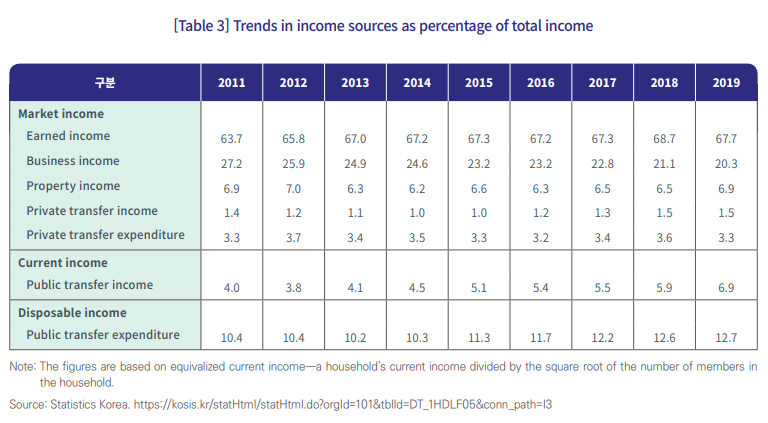
■The relative poverty rate based on market income has increased overall in the 2010s; the decile share ratio based on market income rose to 32.43 in 2019 from 28.2 in 2011.
■Throughout the 2010s, inequality in the primary distribution of income has either remained unchaning (as manifested in the Palma ratio) or worsened (as manifested in the relative poverty rate and the decile share ratio).
- Inequality in disposable income, however, has fallen, as shown in various indicators; the redistributive role of social security policies has grown throughout.■Figures 2 to 4 show trends in relative poverty rate, the decile share ratio, and the Palma ratio throughout the 2010s.
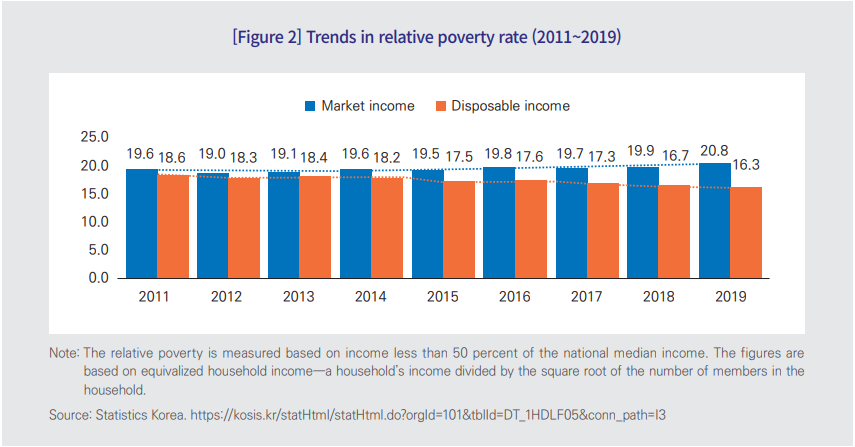
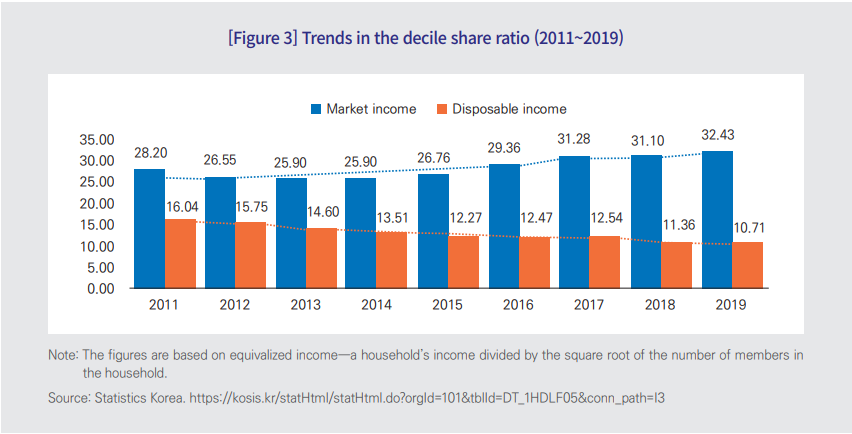
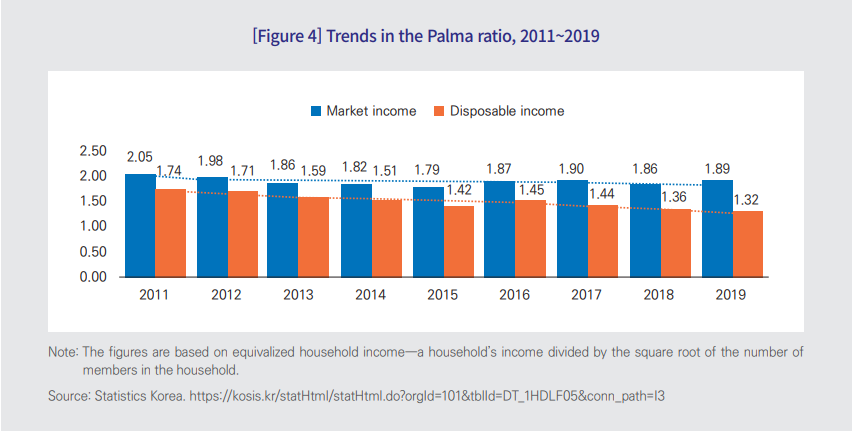
2. The spread of covid-19 and income inequality
■ With its first case reported in December 2019, the novel coronavirus has spread throughout the world. Declared as a pandemic by the WHO in March 2020, covid-19 remains a pandemic. Many countries around the world have locked down their cities. Social distancing has become routine in Korea.
- We need to reduce inequalities that stem from the uneven economic consequences of covid-19, so as to minimize the scars the pandemic will leave behind on people of different income levels.■Figure 6 shows trends in inequality idicators and income redistributive effects pre- and post-covid-19
- Inequality in market income has increased in 2020 year-on-year.
- The redistributive effect of taxes and public transfers has been clearly manifested as inequality in current income and disposable income remained in 2020 at its level in the preceding year.
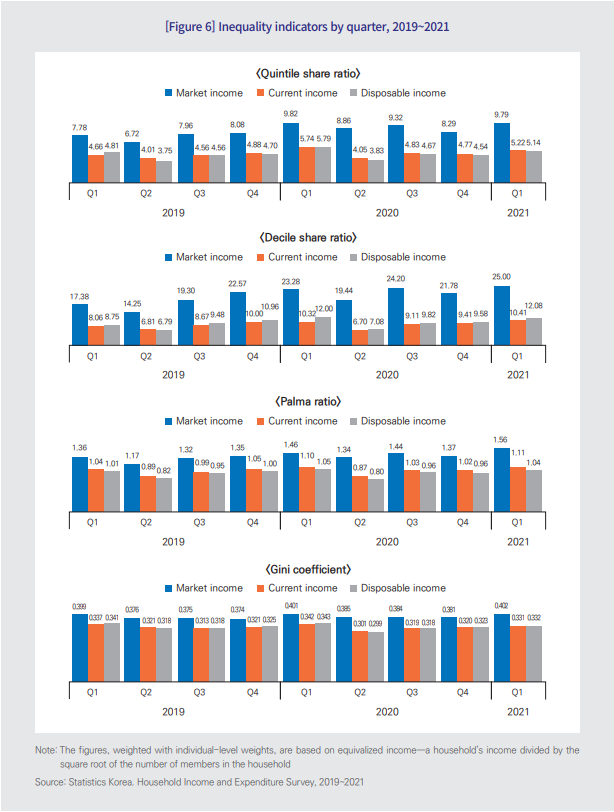
3. Asset inequality
■Figure 7 presents asset inequality as manifested in the Gini index for 2019. The Gini coefficient for total assets was 0.544, that for financial assets was 0.603, and that for real assets was 0.617.
- Assets as a rule were more unequally distributed than was income. Among all the assets examined in this study, the most unequally distributed class of asset was home asset.
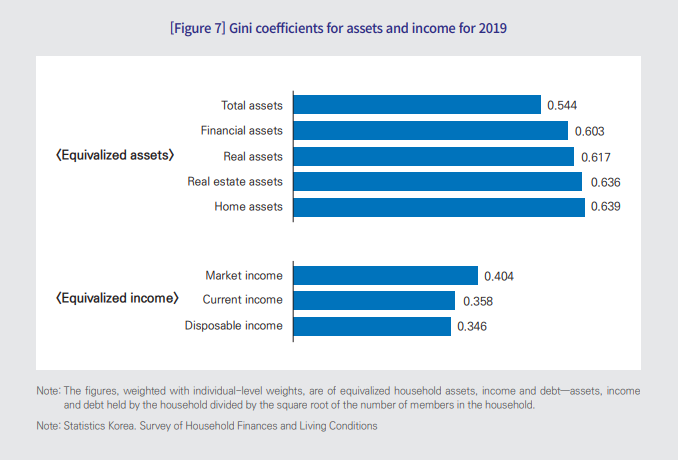
4. Conclusion
■Social risks do not affect different socioeconomic groups in the same way, making thier impact more adverse to some groups than others; social support needs to be focused more on socially vulnerable groups.
- To tackle the inequality embedded in Korea would require multi-faceted policy measures that attend to the distribution of assets, especially home assets, as well as income.
- It is important to take a close look at the distribution taking place in the market, given how worsened the inequality has become in market-income distribution throughout the past decade.
- Some of the inequality that has been left unaddressed by the primary income distribution in the labor market has been assuaged by public transfers and taxes. There is a need to further enhance the role of taxes in reducing ineuqality.
- Inequality has been pointed out in many advanced countries as leading to low growth, damaging to democracy, lowering the overall quality of life in people, which points to the need for a formal income-redistributive mechanism focused on reducing inequalities in socioeconomic conditions.

